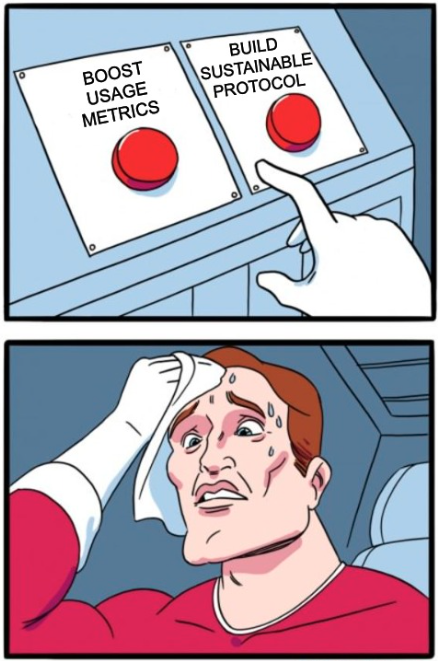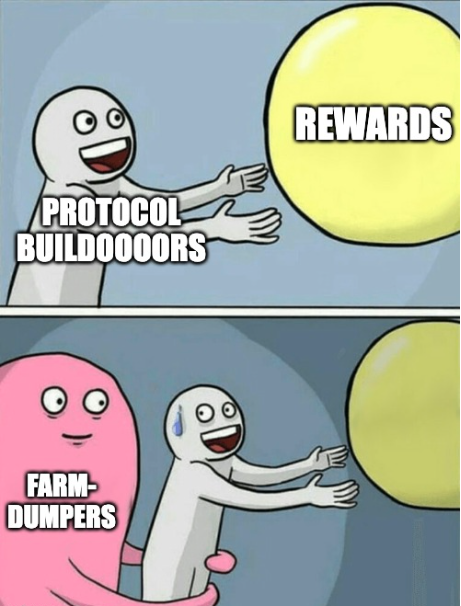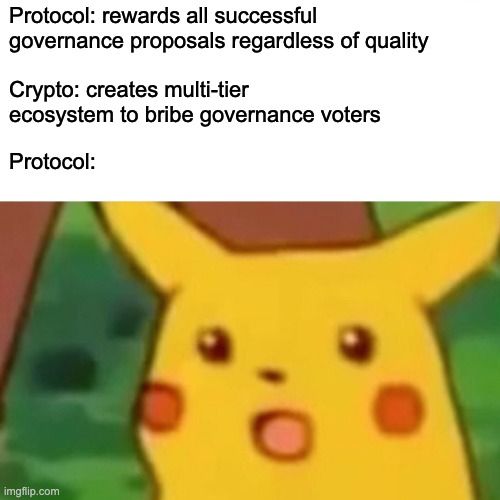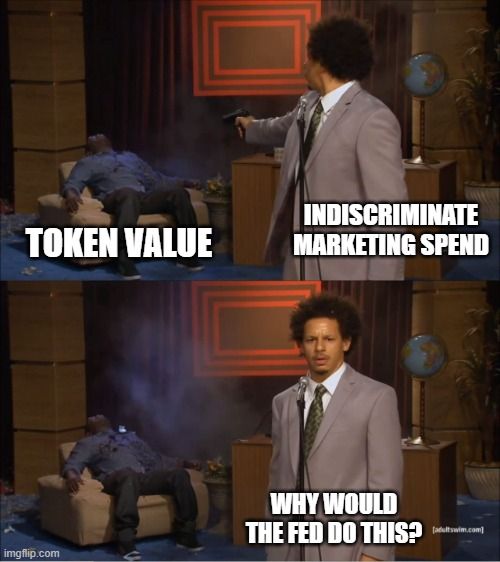TL;DR
- We offer guiding principles for protocol designers looking to create sustainable token economic models (aka tokenomics).
- Tokenomics should: (i) provide common goods that private participants could not access without coordination, and (ii) reward those who create value rather than extract or transfer value.
- We use this framework to analyze some common tokenomic models: gas fees, validator staking, (3,3) staking, governance, and play-to-earn.
Introduction
With the onset of crypto winter, developers, investors, and community members alike have a chance to step back and reassess their perspectives. This reset is especially welcome when it comes to token design, i.e. "tokenomics." For the last two years, many protocols have built tokenomic models that increasingly incentivize short-term outcomes over long-term sustainability. OlympusDAO’s 8,000% APY on OHM tokens and Bored Apes Yacht Club’s non-productive lockups of APE tokens (called out by Cobie) are just two of the more prominent examples of what cropped up during the last bull market.

But this doesn’t have to be so for the next wave of crypto. The calm of winter can allow builders to craft well-grounded token designs. In turn, those designs can deliver sustainable outcomes for the next generation of protocols.
This piece offers a perspective for designers. In particular, we argue that protocol tokens should follow two basic design principles:
- Tokenomics should coordinate common goods that participants would struggle to provide efficiently and economically on their own.
- Tokenomics should channel value towards those who create that value, prioritizing value distribution (aligned with value creation) towards high-utility groups over value transfer between participants.
Similar to our framing of Yield Farming, these design principles are based on the fundamental idea of a rational and value-maximizing economic exchange. There are no free lunches, and short-term gimmicks often come at the cost of enduring value. Builders and participants alike should look for designs that clearly create and distribute fundamental value, and be skeptical towards those that do not.
What is Tokenomics?
The word "tokenomics" is as catchy as it is vaguely defined. Operationally, it is an all-encompassing term to include all of the following design categories:
- Initial supply and allocation to team, investors, community, and other stakeholders
- Methods of distribution including token purchases, airdrops, grants, and partnerships
- Revenue split between users, service providers, and protocol
- Treasury size, structure, and intended uses
- Emission schedule including inflation, mint/burn rights, and supply caps
- Coin governance including voting, escrow, stake-weighting, vesting, and gauges
- Miner and validator compensation such as fees, emissions, and penalties
- Usage of protocol’s native tokens versus external tokens (e.g. ETH, USDC)
For the purpose of this piece, we will treat "tokenomics" as the distribution of token-based incentives, i.e. what should be rewarded and how to reward it. We will focus not on individual and operational questions, but on definitional first principles. It is focused on developing the underlying framework for tokenomics in the abstract. From these first principles, protocol designers can answer each question based on the most pressing tradeoffs and concerns for their particular products.
While this piece may not provide the quick fixes that time-strapped builders are looking for, we think the journey is worthwhile. During the bull market, too many protocols — almost by default — used their tokens for one overriding purpose: to solve the "cold start" problem of usage and awareness. In doing so, these protocols offered high (and at times outrageous) rewards without considering whether this was sustainable or in its long-term interests.
The cold start problem is real, and we believe that some of a good tokenomics model must address it. But by returning to the foundations, we can understand this as one among several competing priorities. A good tokenomics model, grounded in strong design principles, will handle them in a balanced and sustainable way.

Principle 1: Provide Common Goods
The first core principle of a robust tokenomic model is the ability to deliver common goods (and avoid common "bads").[1] A good design should solve collective action problems, organizing and incentivizing its participants to provide services collectively that could not be generated from individual behavior.
To make this concrete, consider the simple example of staking. Without a reward system, no participant would want to secure the network (i.e. bear uncompensated costs singlehandedly to provide diffuse benefits). But with a reward system (typically emissions or fees paid to "stakers"), that decision-making changes. Participants stake for reasons that are individually rational, but — in the aggregate — they provide benefits that are enjoyed by all.
The motivation for common goods in crypto is the same as the one behind taxpayer-funded goods and services such as mass transit, national defense, or public schools. In both cases, a well-designed common good generally has the following properties:
- Positive net utility: total benefits for the community as a whole exceed total costs.
- Inability to privatize: providing the good is uneconomical for individuals privately, due to direct costs and coordination costs.

Principle 2: Align Rewards with Value Creation
The second core principle of a robust tokenomic model is the ability to compensate individuals proportional to the value created (and destroyed). In other words, a good design generates a clear and salient link between actions and rewards to maximize incentives to create value.
At a high level, the compensation (and penalties) to any actor in the system can theoretically be broken into two components: aligned (what they get for providing value) and non-aligned (anything else). For instance, slashing a dishonest validator’s stake would be aligned because the cost is linked to the change (in this case, loss) in value. By contrast, giving a large token bonus to a random validator would be non-aligned, because no value was provided to justify the award.
While this is straightforward in theory, it is more complex in practice. First, often several parties are jointly responsible for any interaction within the system, and attribution is not always measurable. Second, many critical actions have distant payoffs (e.g. allocating community grants, entering into long-term partnerships, etc), making it difficult to create clear incentives upfront. Nevertheless, we believe this is a key principle for which protocol builders should strive.
Moreover, there is a strong link between aligned compensation and long-term value maximization. When protocol designers have the choice between optimizing short-term target metrics and long-term utility, two trends emerge in practice:
- Alignment is healthy: Aligned compensation incentivizes risk — or cost-bearing commitments and other forms of longer-term investment. Conversely, non-aligned compensation encourages mercenary capital which often preserves maximum freedom to exit. For example, "farm-dumping" — where reward tokens are immediately sold — demonstrates non-alignment in yield farming.
- Distortion is costly: Design mechanisms that do not align compensation tend to destroy long-term value, especially when interacting with feedback loops. For instance, giving artificially high rewards to holders of an NFT collection may kick off a speculative run that reverses brutally once the rewards are exhausted — possibly destroying the perceived value of the collection.

Evaluating Current Designs
So far, we have defined our principles in the abstract, but how do they apply to real-world examples? We examine a series of common and concrete tokenomic designs to see how they fare.
Gas Fees
Gas fees are the canonical example of sound crypto-economic design, exemplifying our two principles perfectly.[2] To illustrate, first imagine a blockchain without gas fees. In this scenario, participants face no cost to submitting low-quality transactions (pure spam, in the extreme) that crowd out high-quality and high-priority transactions. At the same time, miners and validators are not rewarded for their computational efforts to process transactions.
Gas fees are thus critical, as we would expect. To evaluate them on our core principles:
- Common good: Yes. Gas fees defend the system from low-quality or resource-intensive transactions that would otherwise make the chain slow or unusable for high-quality transactions. Moreover, fees serve as a coordinating mechanism for participants to coordinate tacitly on relative transaction priority.
- Value alignment: Yes. Compensation is aligned because fees are paid directly from participants, who impose computational costs on the system; and to miners, who provide the computational power necessary for the chain to function.
Fees can be split and optimized in many ways. For instance, Ethereum’s EIP-1559 reduces deadweight loss by introducing a base/priority system that allows users to contest relative priority within a block while minimizing impact on the price of the lowest-priority transaction. (Ethereum has historically had high and variable gas fees, which complicates users’ decisions.) However, all reasonable variants of the gas system accomplish the key objectives of providing common goods and aligning rewards with value creation.
Validator Staking
In proof-of-stake systems, validator staking (and slashing) is another canonical example of good tokenomic design.[3] As before, imagine a blockchain without staking. In this scenario, validators face no penalty for compromising the chain’s security, such as by failing to flag invalid transactions. Given the weakened security, users do not use the network — and the chain is rendered useless.
Staking is thus similarly essential, and can be analyzed under the two core principles:
- Common good: Yes. Staking delivers security to the chain, making it usable to the community. Without such mechanisms, private participants would not be incentivized to provide security, as the costs are direct and the benefits are diffuse. Moreover, staking is a coordinating mechanism for the network to agree on the relative importance of validators.
- Value alignment: Yes. Compensation is aligned for good actors as described above. Moreover, inept or malicious validators forfeit their stakes to the rest of the community as the penalty for weakening security.
Delegated staking shares these same properties. For instance, a user staking Solana on a centralized exchange still contributes to the chain’s security, because the exchange remains motivated to direct its tokens to high-quality validators who will preserve capital.
While staking remains an effective mechanism, there is still room for improvement. In particular, staking is commonly done entirely in the chain’s native token. In extreme cases, this runs the risk of a "doom loop" where a fall in the token’s price leads to reduced security, which leads to a further fall in the token’s price, etc. (See, for instance, the preemptive halting of the Terra chain on May 12 after the fall in LUNA’s price sparked concerns around the ease of an attack.) In such cases, staking would fail to deliver the common good and align value correctly.

(3, 3) and Non-Restrictive "Staking"
Gas fees and validator staking succeed at aligning value on two sides, rewarding good behavior and imposing costs for nonproductive or malicious behavior. In contrast, many of the non-restrictive "staking" rewards currently offered by DeFi protocols neither require users to provide value directly nor ask them for any form of behavioral commitment. The most prominent example is OlympusDAO (and its many imitators), which introduced a "rebase" every eight hours to issue more OHM tokens to staked OHM tokens (sOHM) as long as the backing treasury would support it. While technically locked, sOHM could be unlocked at any point by forfeiting a single rebase’s worth of rewards, making it effectively "OHM with an interest rate."
As many traders will remember, Olympus rocketed to prominence in late 2021 with outlandish APYs (at times rising over 8000%), and attracted capital investments of nearly $5 billion at its peak. The meteoric rise and fall in token price — from $200 to $1300 to $17 — was striking even for crypto. Were these dynamics simply the unavoidable consequence of a speculative environment?
Perhaps, but we offer an alternative hypothesis: the staking mechanism was insufficiently focused on common goods and value alignment. Instead, the mechanism was focused on value transfer from non-stakers to stakers. Let’s see how it does on design principles:
- Common good: Minimal. This form of staking arguably creates two common goods — liquidity and marketing — but at excessive and unsustainable levels. Regarding liquidity, the staking contributed to "protocol-owned liquidity," which allowed the protocol to receive fees for providing liquidity to AMM pools. However, the need for this common resource is questionable, since users can provide liquidity to pools directly.[4] Regarding marketing, the high returns attracted plenty of attention, which is valuable to the extent that attention translates into sustained activity, enhancing the long-term value of the protocol. However, the protocol’s high rewards crowded out all other initiatives, making it harmful in the aggregate.
- Value alignment: No. While moderate (e.g. two digit) rewards could be justified for providing liquidity and marketing, the rewards were massive (four digits). Thus, this mechanism was primarily redistributive in practice, resulting primarily in a value transfer from non-stakers to stakers.
We can also use this lens to understand Cobie’s critique against the Bored Ape Yacht Club for rewarding non-productive "staking." The rewards provided were unlikely to stimulate any real, value-providing use cases, and mostly looked like a way of letting early investors cash out. In prioritizing value transfer (from long-term and passive participants to short-term and extractive ones) over value creation, the mechanism weakened the long-term foundations of the protocol.

Governance
With the difference between productive and non-productive staking in mind, we can look at the more complex design space of token-based governance. Governance should be a fertile design space given the importance of decentralization and broad participation in crypto, but the governance models of most protocols are both simple and highly similar.[5] In fact, most protocol governance can be explained as a combination of two key design choices. Firstly, nearly all protocols follow the rule of "one coin, one vote" (and we’ve written about our concerns with this model before). Secondly, "ve" (vote escrow) models, which give locked tokens more voting power than unlocked tokens, have become increasingly popular as a means of empowering long-term holders. How do these models score on our design principles?
- Common good: Yes. Governance models undeniably create strong common benefits. Firstly, governance models act as coordinating mechanisms enabling diffuse communities to commit to clear actions. Secondly, community-driven models allow protocols to be more flexible and adaptive to changing conditions than they could with hard-coded rules. Finally, community-driven governance can credibly lower the risk of expropriation to builders relative to centralized governance.[6]
- Value alignment: Minimal. Despite creating tremendous common benefits, most governance models perform surprisingly poorly in giving that value back to those who generate it. For instance, voters are usually not rewarded for good decisions and punished for bad decisions; in fact, voters are often not even rewarded for participating over non-voters.[7] To the extent that reward markets (a.k.a. bribes) exist, they incentivize the success of any proposal, whether beneficial or harmful.
On the topic of value alignment, we also note that those who create, research, and steer successful governance proposals typically go unrewarded for their efforts. While there are some innovations (e.g. Vitalik’s discussion of "skin in the game" systems that link long-term outcomes to votes), these are largely hypothetical. The rare exception is the ve model, which better links long-term rewards to governing choices today.[8] This is typically accomplished via lockup a la Curve, but can also occur via non-locking vesting that reverses if liquidity is removed.
Vote escrow notwithstanding, coin governance as a whole is overdue for innovation. There are indeed some efforts to make progress on mitigating the Sibyl attack and better linking votes to identity, e.g. proof-of-personhood systems (as discussed by Fred Ehrsam), pseudonym parties (as discussed by Siddarth et al (2020)), and "web of trust" solutions (ditto). There are also efforts to augment vote escrow models to link voting rights to long-term stakes more efficiently (as discussed by Ong and Reucassel). Future protocol designers should consider this expanded arsenal when designing governance, and experiment with more robust tokenomic designs.

Play-to-Earn
Play-to-earn is where tokenized ownership meets game mechanics, and at first blush should be naturally suited to value alignment, but the reality is more complicated. Compared to traditional games, crypto gaming protocols offer the potential for more sophisticated in-game economies with a broad range of liquid and tradable assets. "Play-to-earn" is a way to distribute ownership of that economy, via token-denominated rewards for participation. In mid-February, for instance, players could earn between $10-$50 per day on Axie Infinity, through a combination of direct rewards for gameplay and additional luck-based rewards (e.g. breeding a rare Axie).
In the last few months, however, many play-to-earn models have come under financial pressure and scrutiny alike. The tokens in the Axie Infinity protocol, for instance, are down over 85% from mid-February as of writing, severely compressing earnings potential. Token value aside, how does the play-to-earn model perform on our two key principles?
- Common good: Moderate. In theory, play-to-earn models can help the game solve the "cold start" problem, when the game requires some critical mass (or strength of network effects) to be fun for a general audience. Without an incentive mechanism, games such as MMOs may be unable to attract initial participants, condemning even good games to failure. However, an ideal model would reward early players only until critical mass was achieved. In practice, play-to-earn models usually dispense more valuable rewards as momentum accumulates and price rises (often driven by asset scarcity). At this point, the rewards simply transfer value from the protocol to players, boosting short-term usage at the expense of long-term sustainability.
- Value alignment: Moderate. Again, in theory, play-to-earn models share rewards with early participants, who provide value by playing the game before it is compelling enough on its own. However, most play-to-earn games transfer value to early participants regardless of whether they contribute to the game community. This lack of alignment benefits short-term actors and distorts the community’s growth.
The primary issue with play-to-earn as currently implemented is the efficiency of value distribution, in the sense of aligned rewards over total rewards. Broadly, the ideal mechanism to reward early community builders would reward only actions that make the game more enjoyable for all, only when they are needed to build critical mass, and only for ongoing contributions.[9]
Of course, problems can be more subtle — but the same principles apply. For instance, if a game’s current mechanics attract low-skilled players primarily, designers could focus on rewarding skill in each match (e.g. larger rewards for beating better players) rather than rewarding the number of matches played. If the problem is early stakeholders collecting an outsize share of rewards when token price rises, designers could tie rewards to some global activity metric. Finally, if the cold start problem is the most critical, rewards could taper. More specifically, a web3 game developer could let the first thousand players for a new game lock in a boosted reward rate for the initial weeks, with smaller rewards for later weeks or later players.
While play-to-earn is the clearest example of the challenges in value alignment, the preceding discussion also applies to any "X-to-earn" where rewards are distributed for specific actions. Stepn, for instance, is a pioneer with the move-to-earn model. We would suggest these protocols think carefully about the types of value they want their tokenomics to incentivize and reward.

Future Ideas for Tokenomics
So far we have applied our principles retroactively, grading existing models on their performance. A useful design framework can also be applied proactively, allowing us to generate new ideas. In particular, how else might we deliver direct and targeted incentives to individual supporters of common goods?
- Decentralization: Miner honesty is heavily incentivized in practice, but miner diversity is rarely considered. But in theory, miner diversity — measured through ideas such as the Nakamoto coefficient — is well-understood as a form of common good. Would it make sense to impose a progressive tax on validator rewards above a certain stake size?
- Marketing: Awareness is critical to the survival of a protocol, so there is value to simply being first in the sense of providing initial liquidity or usage for a network. However, as with play-to-earn, participation driven by artificial rewards may be non-additive or harmful once the protocol attains critical mass. Could a protocol reward early backers by giving larger rewards to the first $X million TVL, then amortizing those bonuses as total liquidity rises? (APY already declines as TVL rises, so this would be a sharper tapering above some desired liquidity level.)
- Grants and partnerships: Token cap tables frequently include a large, open-ended allocation for developers who build for a protocol and partners who integrate with it. However, these rewards can be fairly diffuse and gameable. Would it be possible to tie grant-based token rewards to on-chain metrics in a non-exploitable way?

Conclusion
Token design is difficult because it requires answering a highly abstract, open-ended question: what deserves to be incentivized? It would be ideal if protocols could try different models, solicit early feedback, and iterate. But most teams only get one chance to set the dynamics of the system and must provide a solid foundation on the first try. We believe that following these two core principles — creating common goods and aligning rewards — will give these teams the best chance of long-term success.
The burden falls on the broader community, too. Early investors, retail participants, and protocol users alike should push for strong and principled tokenomics — now more than ever. Many of the momentum-oriented designs of the last crypto bull market could only persist in such frothy markets. Despite their drawbacks, bear markets necessitate real utility from the start.

Please let us know if we missed anything — we are always aiming to engage with the crypto community and deepen our own understanding. Thanks to the research team at Jump Crypto and especially to Anirudh Suresh, Daniel Gerhardstein, and Maher Latif for feedback. This note does not constitute financial advice.
- We use "common goods" rather than "public goods" because our focus is the economics of providing and maintaining collective resources. This often overlaps with the public/private distinction but is not strictly synonymous with it. In economic parlance, public goods specifically refer to goods that are non-rivalrous and non-excludable. In contrast, the definition of common goods is more concerned with embedding positive and negative externalities. These goods may also be non-rivalrous and non-excludable, but are not necessarily so. ↩︎
- Gas fees are the fees participants pay to have their transactions included on the blockchain. These fees are incurred regardless of whether the transaction succeeds or fails. Moreover, these fees typically fluctuate with demand for limited block space, and most protocols utilize an auction mechanism to set prices. ↩︎
- In its original sense, staking is the act of providing token collateral as part of a commitment to acting as an honest validator. The validator is rewarded for successful participation, but punished via loss of this stake for failure or malicious actions. In many proof-of-stake consensus systems, other participants are also allowed to entrust their stakes to validators (delegated staking) and share in the rewards. ↩︎
- It is important to stress that liquidity does have common-good properties, because it allows use cases to be built atop the token. Our concern here is that OlympusDAO heavily over-incentivized the provision of liquidity, and in a manner that seemed duplicative with existing mechanisms. ↩︎
- Despite the substantial benefits of governance, we stress that governance is one of several components in a robust tokenomics model. Many protocols design their token solely to be used as a governance token. That narrow-minded focus misses many other core functions — from security to liquidity to marketing — required for a well-designed protocol. ↩︎
- This third benefit is sometimes missed by protocols that utilize the one token/one vote model, as a handful of whales can effectively turn such protocols into oligarchic structures. One might consider this a form of "soft rug." ↩︎
- In Curve-like AMMs, voters are rewarded indirectly for their participation via additional fees allocated towards the target pools. This model does provide some form of individual value alignment, but at the cost of disincentivizing good collective governance, as voters are incentivized to selfishly vote towards their own pools or the ones offering the highest bribe. On Solidly, another Curve-like AMM, voters instead earn fees from all pools they vote for. This encourages a better equilibrium where users vote for pools that generate high fees, which are presumably those that provide high utility. ↩︎
- Regular governance and voting escrow deliver the same set of common good benefits, but ve models provide more substantial value alignment. This is because the most empowered voters "pay for" their power with longer lockups, committing to stick around and enjoy the benefits or suffer the consequences of their choices. ↩︎
- Coordinated activity (e.g. guilds) will arise in either scenario, but they will behave very differently depending on the exact behavior rewarded and the difficulty of exploiting the corresponding metric. ↩︎
